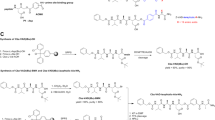Abstract
In recent years, several inhibitors that prevent caspase activation and apoptosis have emerged. At high doses, however, these inhibitors can have nonspecific effects and/or become cytotoxic. In this study, we determined the effectiveness of broad spectrum caspase inhibitors to prevent apoptosis. A carboxy terminal phenoxy group conjugated to the amino acids valine and aspartate (Q-VD-OPh) potently inhibited apoptosis. Q-VD-OPh was significantly more effective in preventing apoptosis than the widely used inhibitors, ZVAD-fmk and Boc-D-fmk, and was also equally effective in preventing apoptosis mediated by the three major apoptotic pathways, caspase 9/3, caspase 8/10, and caspase 12. In addition to the increased effectiveness, Q-VD-OPh was not toxic to cells even at extremely high concentrations. Our data indicate that the specificity, effectiveness, and reduced toxicity of caspase inhibitors can be significantly enhanced using carboxyterminal o-phenoxy groups and may have important uses in vivo.
Similar content being viewed by others
References
Plas DR, Thompson CB. Cell metabolism in the regulation of programmed cell death. Trends Endocrinol Metab 2002; 13: 75-78.
Earnshaw WC, Martins LM, Kaufmann SH. Mammalian caspases: Structure, activation, substrates, and functions during apoptosis. Annu Rev Biochem 1999; 68: 383-424.
Salvesen GS, Dixit VM. Caspases: Intracellular signaling by proteolysis. Cell 1997; 91: 443-446.
Cohen GM. Caspases: The executioners of apoptosis. Biochem J 1997; 326: 1-16.
Brown TL, Patil S, Howe PH. Analysis of TGF?-inducible apoptosis. In: Howe P, ed. Methods in Molecular Biology-“Transforming Growth Factor-Beta Protocols.” Vol. 142. Totowa, NJ: Humana Press 2000; 149-167
Goldstein JC, Waterhouse NJ, Juin P, Evan GI, Green DR. The coordinate release of cytochrome c during apoptosis is rapid, complete and kinetically invariant. Nat Cell Biol 2000; 2: 156-162.
Yin XM. Signal transduction mediated by Bid, a pro-death Bcl-2 family proteins, connects the death receptor and mitochondria apoptosis pathways. Cell Res 2000; 10: 161-167.
Fujino M, Li XK, Kitazawa Y, Guo L, Kawasaki M, Funeshima N, Amano T, Suzuki S. Distinct pathways of apoptosis triggered by FTY720, etoposide, and anti-Fas antibody in human Tlymphoma cell line (Jurkat cells). J Pharmacol Exp Ther 2002; 300: 939-945.
Robertson JD, Enoksson M, Suomela M, Zhivotovsky B, Orrenius S. Caspase-2 acts upstream of mitochondria to promote cytochrome c release during etoposide-induced apoptosis. J Biol Chem 2002; 277: 29803-29809.
Nakagawa T, Zhu H, Morishima N, Li E, Xu J, Yankner BA, Yuan J. Caspase-12 mediates endoplasmic-reticulum-specific apoptosis and cytotoxicity by amyloid-beta. Nature 2000; 403: 98-103.
Rao RV, Hermel E, Castro-Obregon S, del Rio G, Ellerby LM, Ellerby HM, Bredesen DE. Coupling endoplasmic reticulum stress to the cell death program. Mechanism of caspase activation. J Biol Chem 2001; 276: 33869-33874.
Fischer H, Koenig U, Eckhart L, Tschachler E. Human caspase 12 has acquired deleterious mutations. Biochem Biophys Res Commun. 2002; 293(2): 722-726.
Schotte P, Declercq W, Van Huffel S, Vandenabeele P, Beyaert R. Non-specific effects of methyl ketone peptide inhibitors of caspases. FEBS Lett 1999; 442: 117-121.
Van Noorden CJ. The history of Z-VAD-FMK, a tool for understanding the significance of caspase inhibition. Acta Histochem 2001; 103: 241-251.
Brown TL, Patil S, Basnett RK, Howe PH. Caspase inhibitor BD-fmk distinguishes transforming growth factor b-induced apoptosis from growth inhibition. Cell Growth Diff 1998; 9: 869-875.
Brown TL, Patil S, Cianci CD, Morrow JS, Howe PH. TGF beta induces caspase 3 independent cleavage of alpha II spectrin (alpha-fodrin) coincident with apoptosis. J Biol Chem 1999; 274: 23256-23262.
Mischak R. Apoptosis. ICN/ESP Caspase inhibitors: Applications in vivo and in vitro. ICN Bioconcepts 2002; 8: 1-5.
Patil S, Wildey GM, Brown TL, Choy L, Derynck R, Howe PH. Smad7 is induced by CD40 and protects WEHI 231 Blymphocytes from transforming growth factor-beta-induced growth inhibition and apoptosis. J Biol Chem 2000; 275: 38363-38370.
Fischer G, Kent SC, Joseph L, Green DR, Scott DW. Lymphoma models for B cell activation and tolerance. X. Anti-mu-mediated growth arrest and apoptosis of murine B cell lymphomas is prevented by the stabilization of Myc. J Exp Med 1994; 179: 221-228.
Warner GL, Ludlow JW, Nelson DA, Gaur A, Scott DW. Anti-immunoglobulin treatment of murine B-cell lymphomas induces active transforming growth factor beta but pRB hypophosphorylation is transforming growth factor beta independent. Cell Growth Diff 1992; 3: 175-181.
Wu M, Bellas RE, Shen J, Yang W, Sonenshein GE. Increased p27Kip1 cyclin dependent kinase inhibitor gene expression following anti-IgM treatment promotes apoptosis of WEHI 231 B cells. J Immunol 1999; 163: 6530-6535.
Wu M, Arsura M, Bellas RE, FitzGerald MJ, Lee H, Schauer SL, Sherr DH, Sonenshein GE. Inhibition of c-myc expression induces apoptosis of WEHI 231 murine B cells. Mol Cell Biol 1996; 16: 5015-5025.
Lee JR, Koretzky GA. Extracellular signal-regulated kinase-2, but not c-Jun NH2-terminal kinase, activation correlates with surface IgM-mediated apoptosis in the WEHI 231 B cell line. J Immunol 1998; 161: 1637-1644.
Fang W, Rivard JJ, Ganser JA, LeBien TW, Nath KA, Mueller DL, Behrens TW. Bcl-xL rescues WEHI 231 B lymphocytes from oxidant-mediated death following diverse apoptotic stimuli. J Immunol 1995; 155: 66-75.
Chen L, Kim TJ, Pillai S. Inhibition of caspase activity prevents anti-IgM induced apoptosis but not ceramide generation in WEHI 231 B cells. Mol Immunol 1998; 35: 195-205.
Author information
Authors and Affiliations
Corresponding author
Rights and permissions
About this article
Cite this article
Caserta, T.M., Smith, A.N., Gultice, A.D. et al. Q-VD-OPh, a broad spectrum caspase inhibitor with potent antiapoptotic properties. Apoptosis 8, 345–352 (2003). https://doi.org/10.1023/A:1024116916932
Issue Date:
DOI: https://doi.org/10.1023/A:1024116916932




